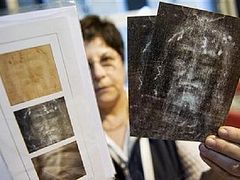Turin, Italy, July 14, 2017
New atomic resolution research indicates that the mysterious Shroud of Turin does in fact contain the blood of a torture victim, thus undermining theories that the shroud was painted, reports Catholic News Agency.
“On the basis of the experimental evidences of our atomic resolution TEM studies, the man wrapped in the [Shroud of Turin] suffered a strong polytrauma,” reads the conclusion of the new study. The research was carried out by the Instituo Officia dei Materiali in Trieste and the Institute of Crystallography in Bari, both under Italy’s National Research Council, as well as the University of Padua’s Department of Industrial Engineering, with the results published in the article “New Biological Evidence from Atomic Resolution Studies on the Turin Shroud” in the multidisciplinary open access, peer-reviewed journal PLOS ONE.
Very small particles attached to the linen fibers of the shroud “have recorded a scenario of great suffering, whose victim was wrapped up in the funeral cloth,” said Elvio Carlino, a researcher at the Institute of Crystallography. These “nanoparticles” are of a very particular structure, size, and distribution, and are not typical for the blood of a healthy person, but rather contain levels of creatinine and ferritin found in patients who endured multiple violent traumas, such as torture.
“Hence, the presence of these biological nanoparticles found during our experiments point to a violent death for the man wrapped in the Turin Shroud,” said University of Padua professor Giulio Fanti.
The findings contradict skeptics’ claims that the shroud is merely a painted object: “There is a wide recent literature reporting on interaction between creatinine and ferritin in fatal accident or as a consequence of the rhabdomyolysis due to torture. […] This result cannot be impressed on the TS by using ancient dye pigments, as they have bigger sizes and tend to aggregate, and it is highly unlikely that the eventual ancient artist would have painted a fake by using the hematic serum of someone after a heavy polytrauma,” the article reads.
This most recent study, dealing with particles on the nanoscale, was only made possible by recent developments in the field of electron microscopy. A nanometer is one billionth of a meter. Researchers drew on experimental evidence of atomic resolution studies and recent medical studies on patients who suffered multiple acts of trauma and torture.
***
The Shroud of Turin remains largely wrapped in mystery. Historical documents speaking of the Shroud dating back to the 14th century have been preserved. It is commonly believed that there is no evidence of its existence before that, although Fr. Alexey Young shows that there are numerous mentions of the Lord’s burial cloth throughout the first centuries of the Church. The Shroud has been on display at the Cathedral of St. John the Baptist in Turin, Italy since the 17th century.
Scientific analyses of the shroud have returned widely varying results. Radiocarbon dating tests from 1988 determined the Shroud originated between 1260 and 1390, although it is believed the section of cloth then dated had been repaired at some point. Research from earlier this year may indicate that the imprint of coins with the image of Tiberius Caesar are found on the Shroud, placing it at around the year 29 AD, although this is of course disputed. Giulio Fanti’s 2013 book The Mystery of the Shroud maintains that the cloth dates to the 1st century AD.





